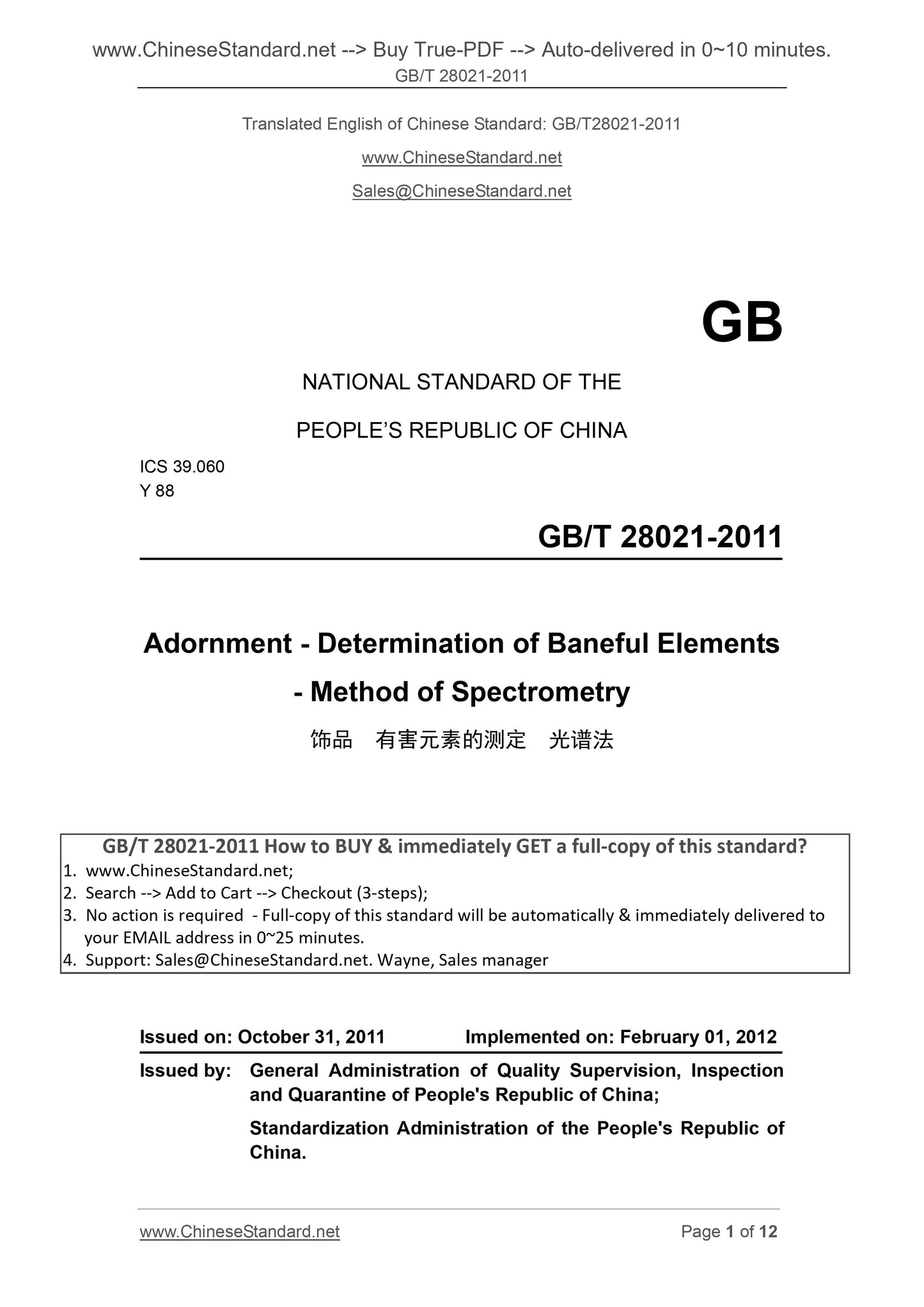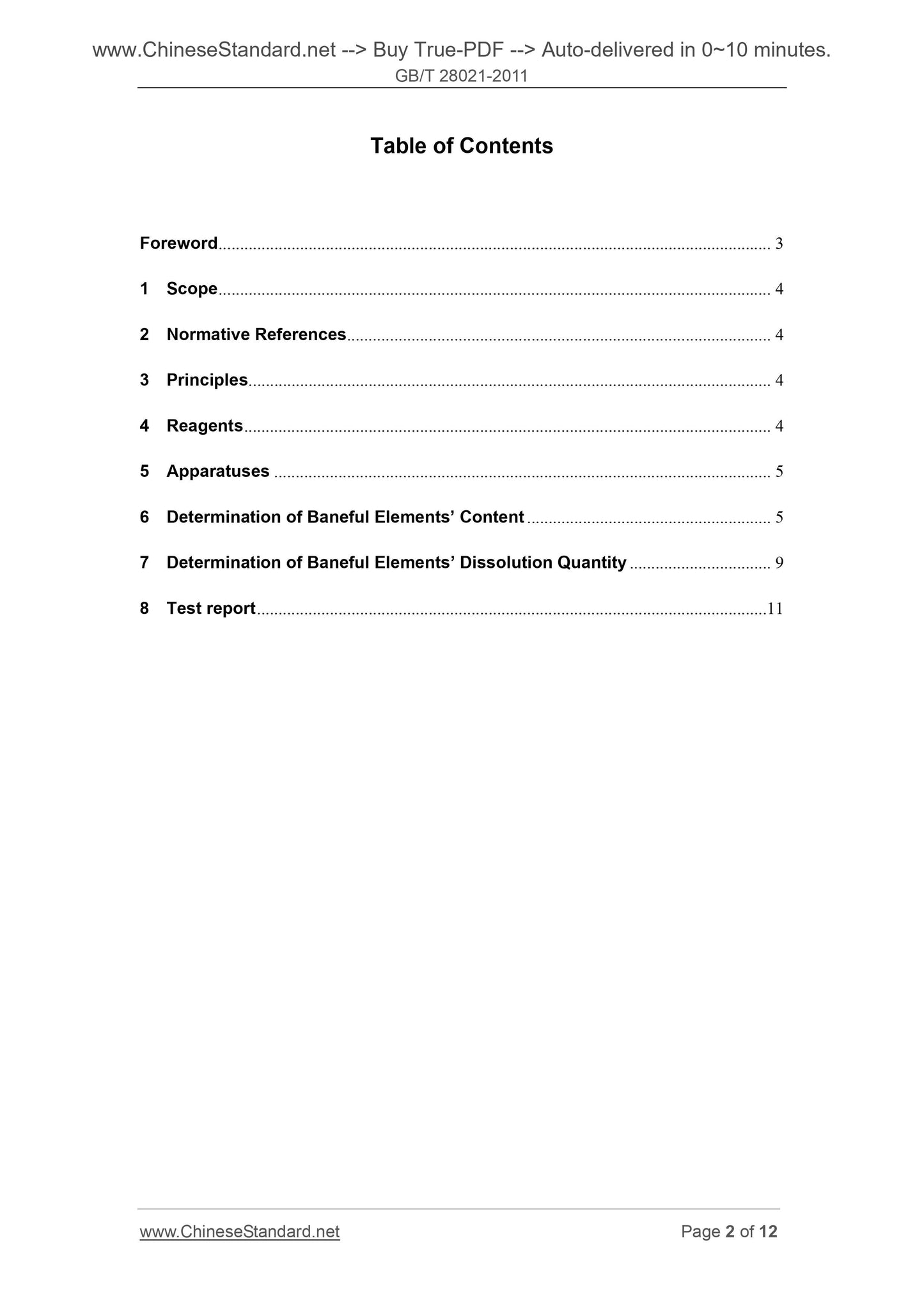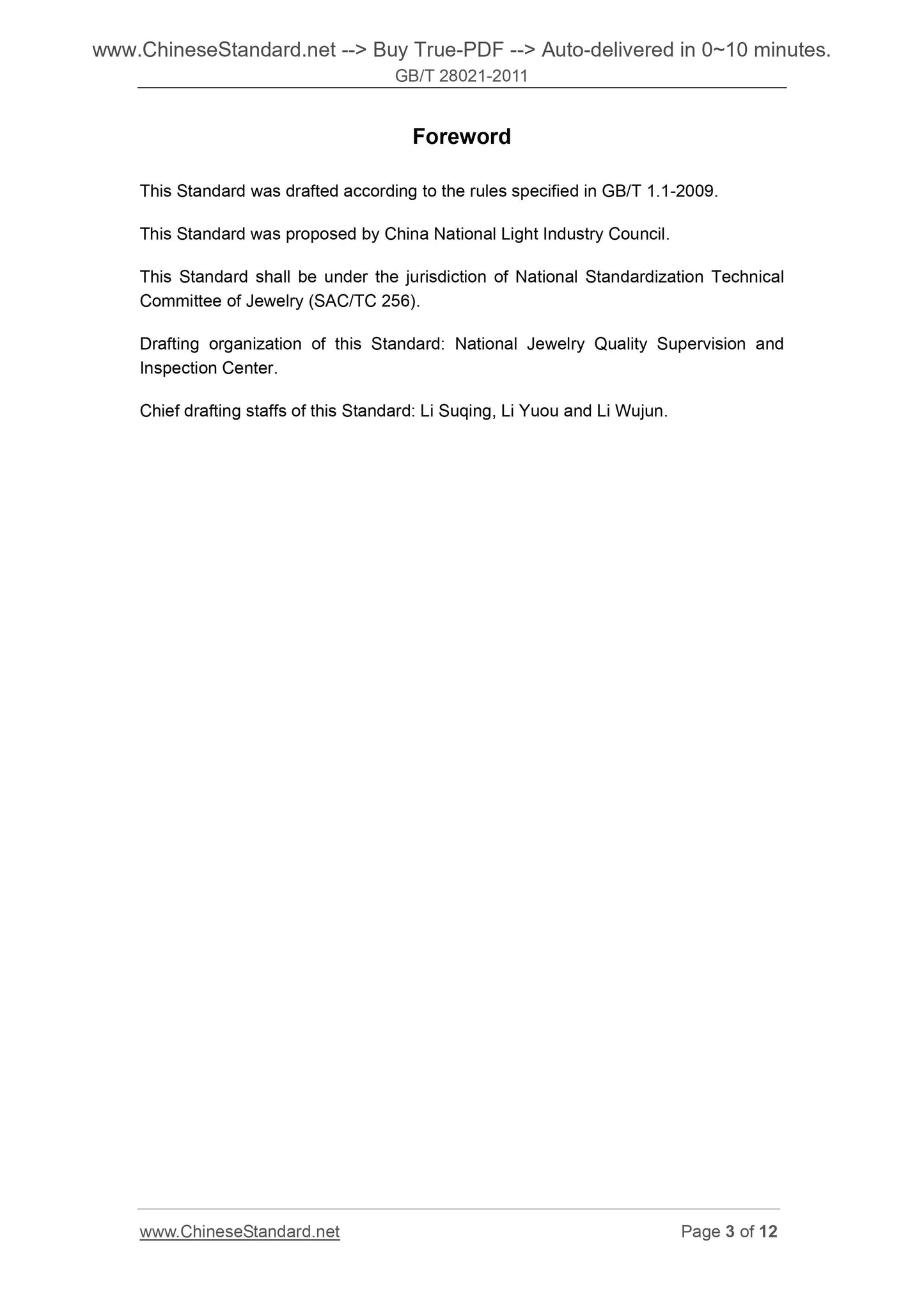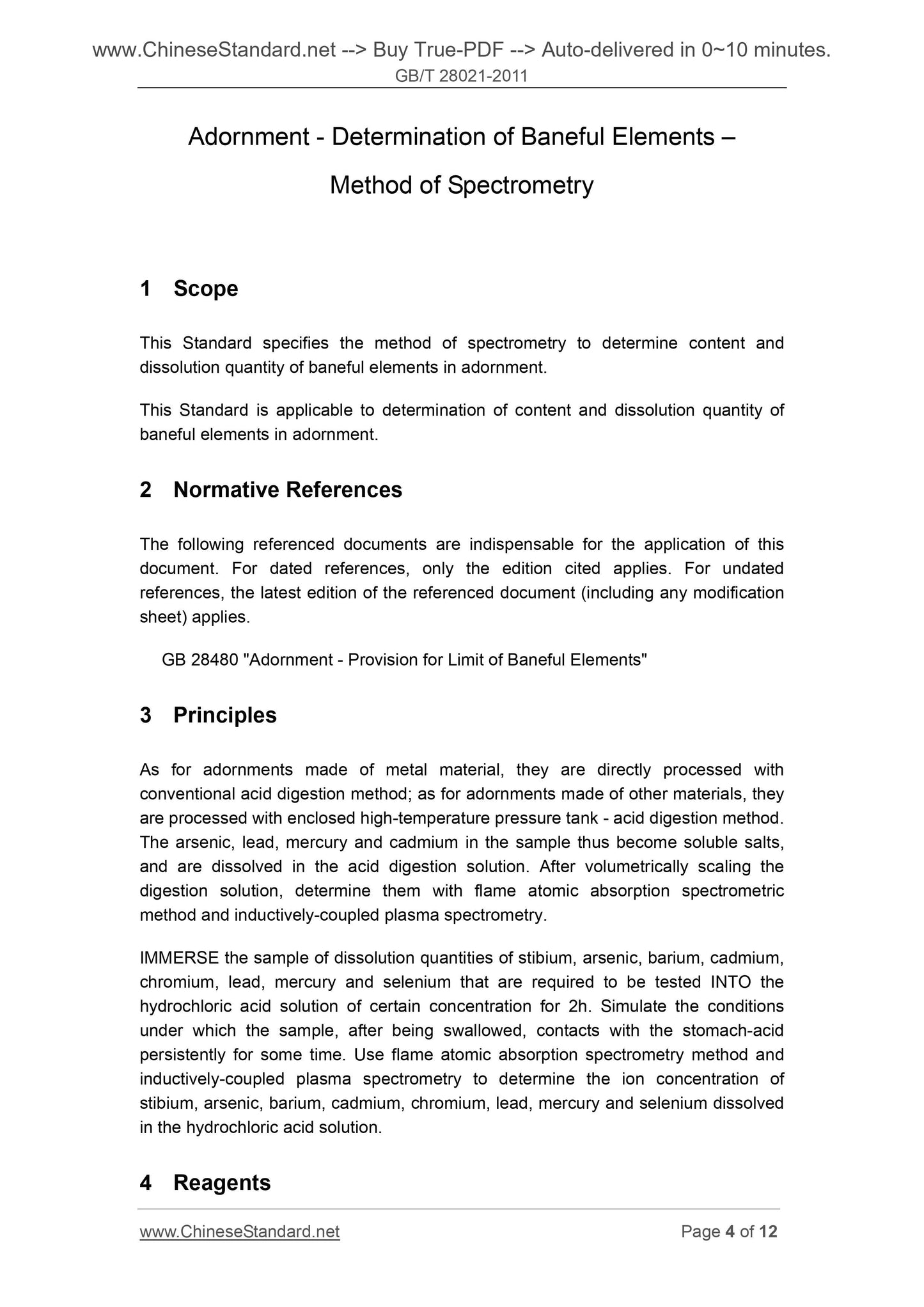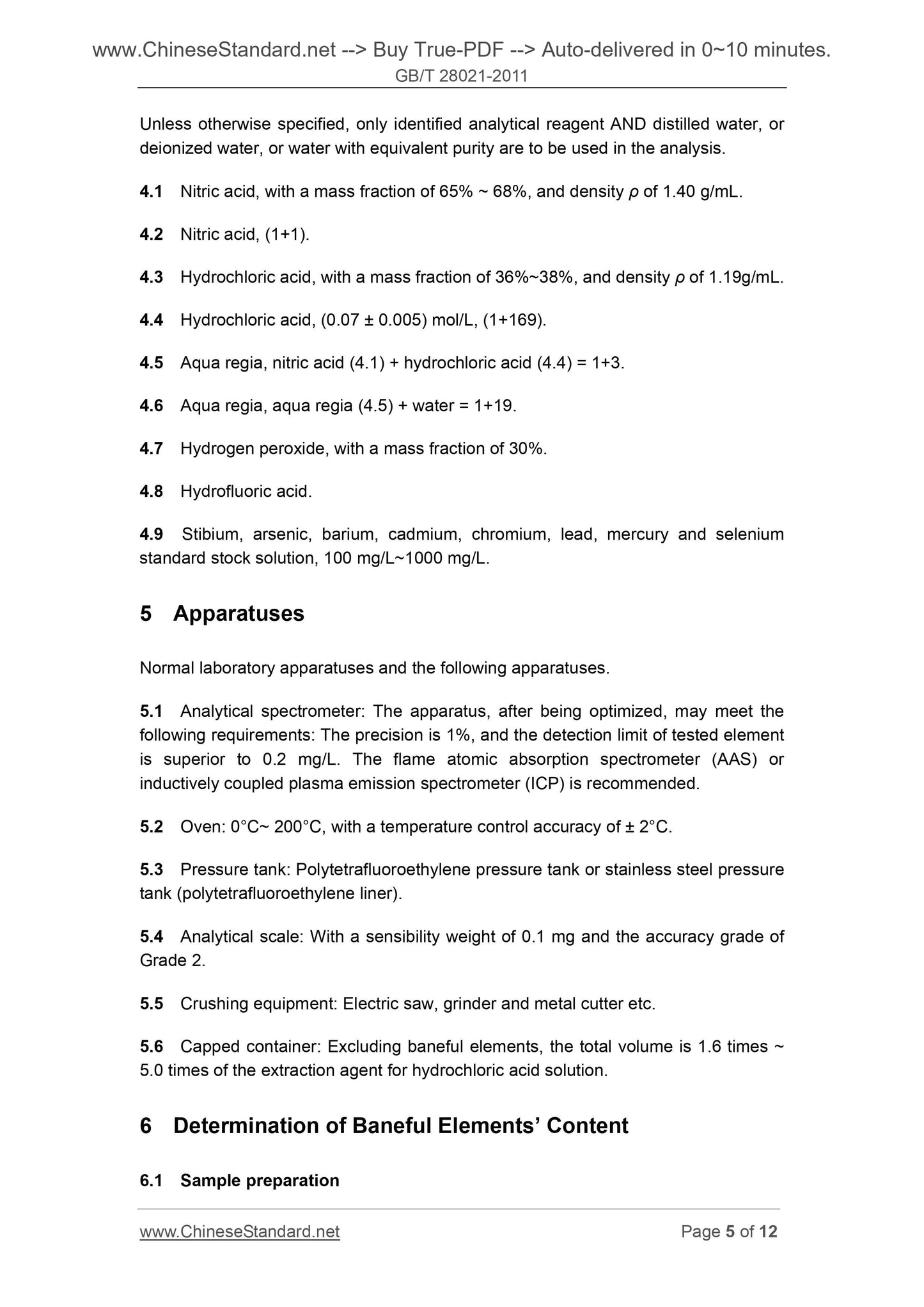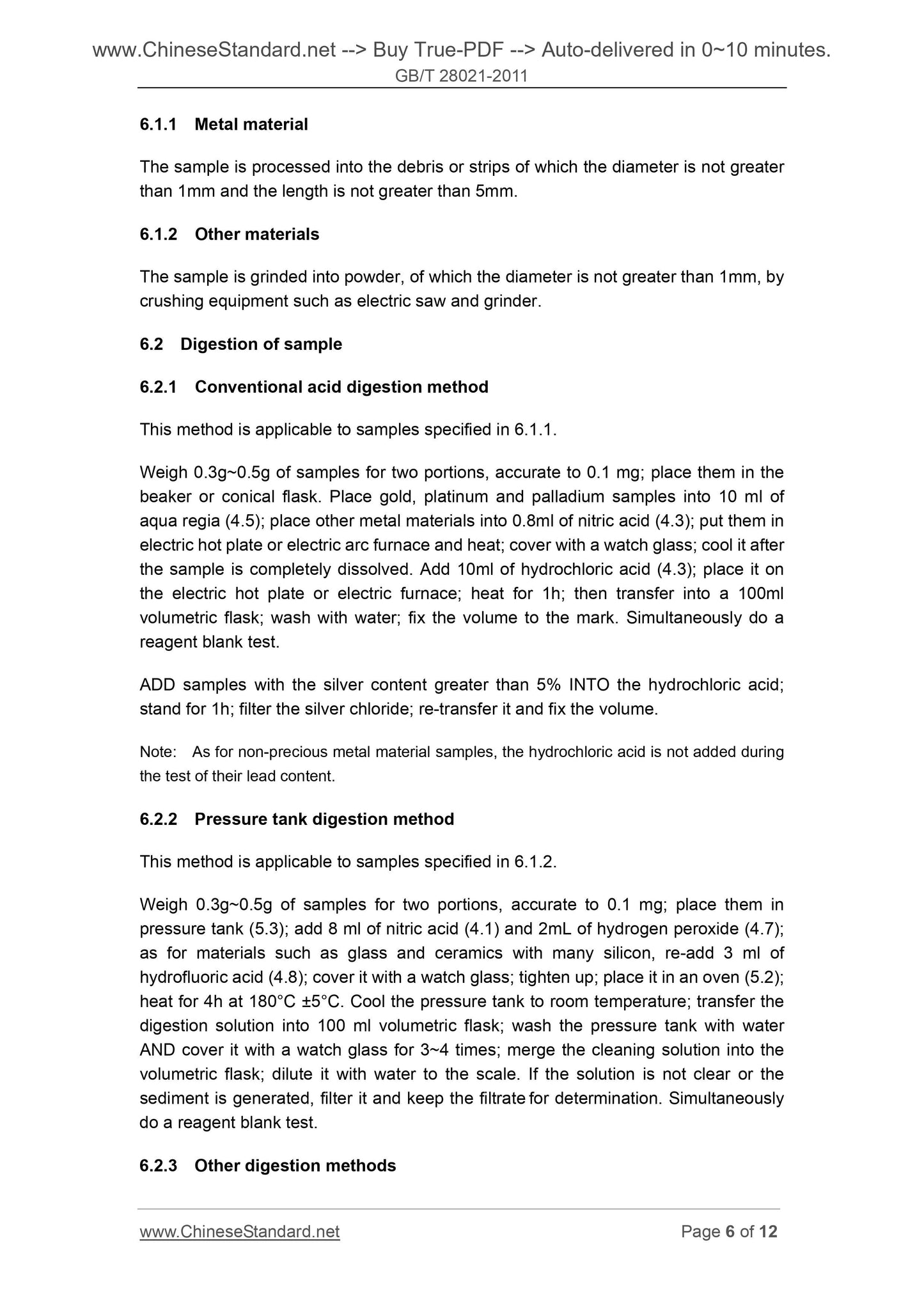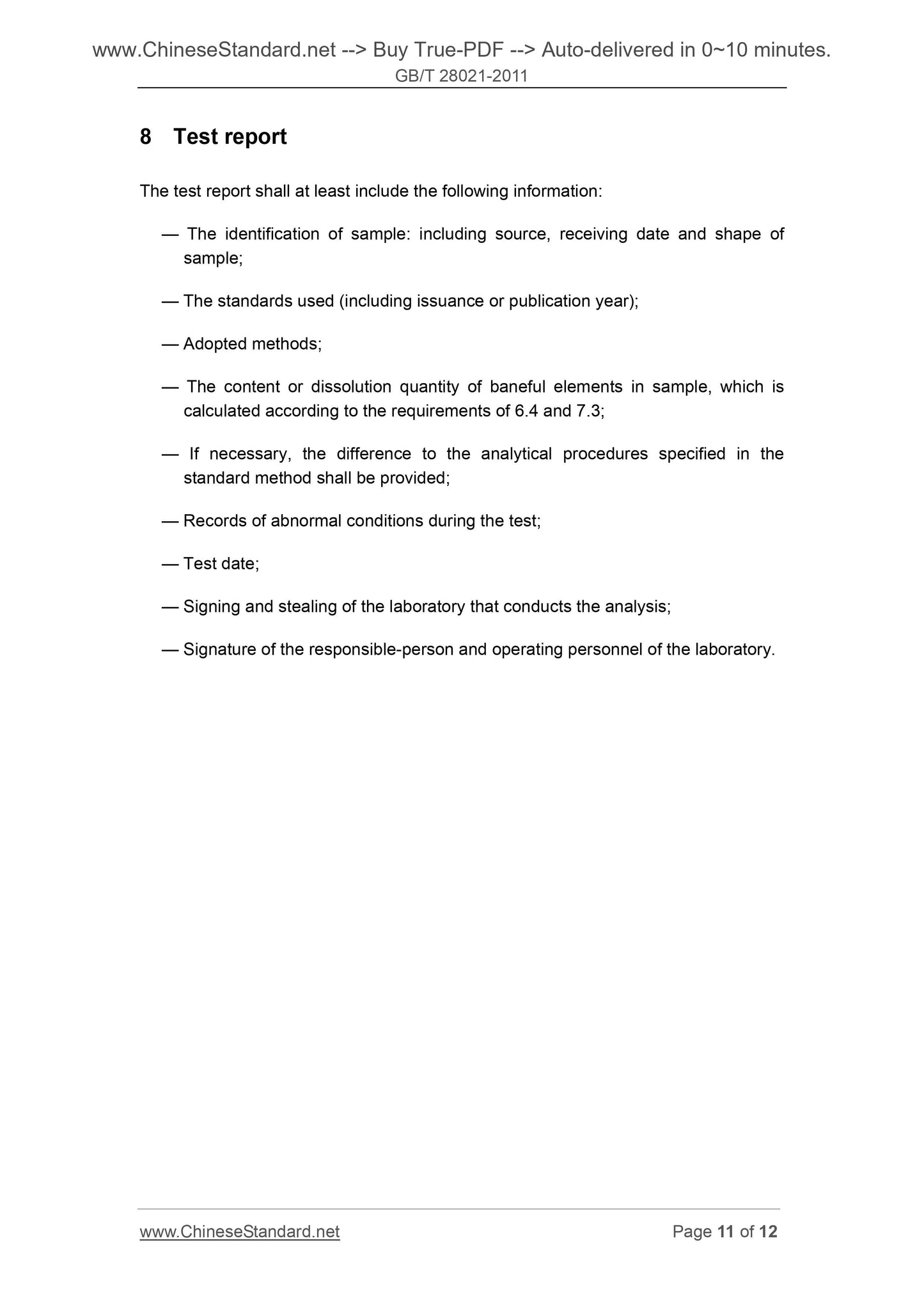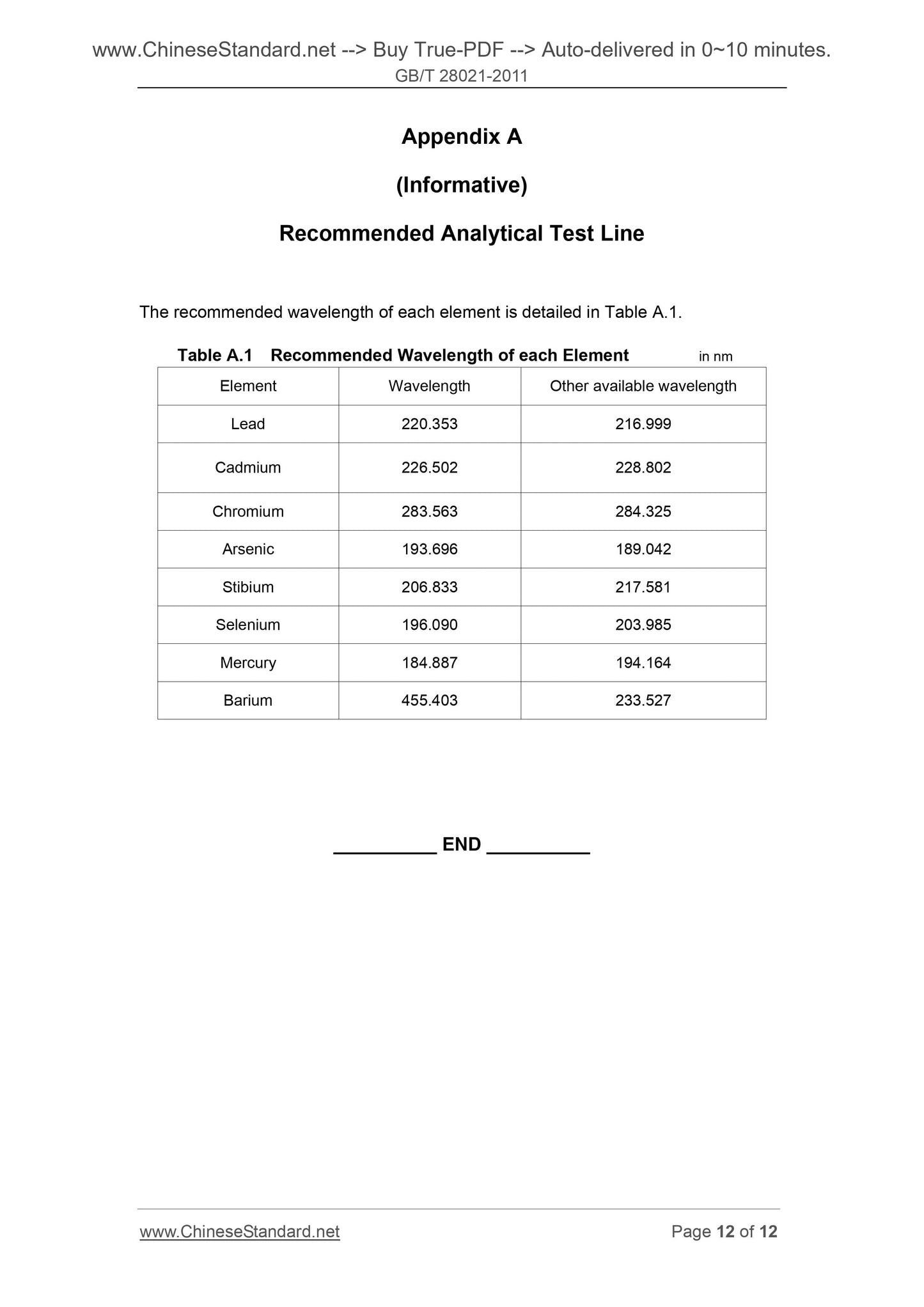1
/
of
8
PayPal, credit cards. Download editable-PDF and invoice in 1 second!
GB/T 28021-2011 English PDF (GB/T28021-2011)
GB/T 28021-2011 English PDF (GB/T28021-2011)
Regular price
$70.00 USD
Regular price
Sale price
$70.00 USD
Unit price
/
per
Shipping calculated at checkout.
Couldn't load pickup availability
Delivery: 3 seconds. Download true-PDF + Invoice.
Get QUOTATION in 1-minute: Click GB/T 28021-2011
Historical versions: GB/T 28021-2011
Preview True-PDF (Reload/Scroll if blank)
GB/T 28021-2011: Adornment -- Determination of baneful elements -- Method of spectrometry
GB/T 28021-2011
GB
NATIONAL STANDARD OF THE
PEOPLE’S REPUBLIC OF CHINA
ICS 39.060
Y 88
Adornment - Determination of Baneful Elements
- Method of Spectrometry
ISSUED ON. OCTOBER 31, 2011
IMPLEMENTED ON. FEBRUARY 01, 2012
Issued by. General Administration of Quality Supervision, Inspection
and Quarantine of People's Republic of China;
Standardization Administration of the People's Republic of
China.
Table of Contents
Foreword ... 3
1 Scope ... 4
2 Normative References... 4
3 Principles ... 4
4 Reagents ... 4
5 Apparatuses ... 5
6 Determination of Baneful Elements’ Content ... 5
7 Determination of Baneful Elements’ Dissolution Quantity ... 9
8 Test report ...11
Foreword
This Standard was drafted according to the rules specified in GB/T 1.1-2009.
This Standard was proposed by China National Light Industry Council.
This Standard shall be under the jurisdiction of National Standardization Technical
Committee of Jewelry (SAC/TC 256).
Drafting organization of this Standard. National Jewelry Quality Supervision and
Inspection Center.
Chief drafting staffs of this Standard. Li Suqing, Li Yuou and Li Wujun.
Adornment - Determination of Baneful Elements –
Method of Spectrometry
1 Scope
This Standard specifies the method of spectrometry to determine content and
dissolution quantity of baneful elements in adornment.
This Standard is applicable to determination of content and dissolution quantity of
baneful elements in adornment.
2 Normative References
The following referenced documents are indispensable for the application of this
document. For dated references, only the edition cited applies. For undated
references, the latest edition of the referenced document (including any modification
sheet) applies.
GB 28480 "Adornment - Provision for Limit of Baneful Elements"
3 Principles
As for adornments made of metal material, they are directly processed with
conventional acid digestion method; as for adornments made of other materials, they
are processed with enclosed high-temperature pressure tank - acid digestion method.
The arsenic, lead, mercury and cadmium in the sample thus become soluble salts,
and are dissolved in the acid digestion solution. After volumetrically scaling the
digestion solution, determine them with flame atomic absorption spectrometric
method and inductively-coupled plasma spectrometry.
IMMERSE the sample of dissolution quantities of stibium, arsenic, barium, cadmium,
chromium, lead, mercury and selenium that are required to be tested INTO the
hydrochloric acid solution of certain concentration for 2h. Simulate the conditions
under which the sample, after being swallowed, contacts with the stomach-acid
persistently for some time. Use flame atomic absorption spectrometry method and
inductively-coupled plasma spectrometry to determine the ion concentration of
stibium, arsenic, barium, cadmium, chromium, lead, mercury and selenium dissolved
in the hydrochloric acid solution.
4 Reagents
Unless otherwise specified, only identified analytical reagent AND distilled water, or
deionized water, or water with equivalent purity are to be used in the analysis.
4.1 Nitric acid, with a mass fraction of 65% ~ 68%, and density ρ of 1.40 g/mL.
4.2 Nitric acid, (1+1).
4.3 Hydrochloric acid, with a mass fraction of 36%~38%, and density ρ of 1.19g/mL.
4.4 Hydrochloric acid, (0.07 ± 0.005) mol/L, (1+169).
4.5 Aqua regia, nitric acid (4.1) + hydrochloric acid (4.4) = 1+3.
4.6 Aqua regia, aqua regia (4.5) + water = 1+19.
4.7 Hydrogen peroxide, with a mass fraction of 30%.
4.8 Hydrofluoric acid.
4.9 Stibium, arsenic, barium, cadmium, chromium, lead, mercury and selenium
standard stock solution, 100 mg/L~1000 mg/L.
5 Apparatuses
Normal laboratory apparatuses and the following apparatuses.
5.1 Analytical spectrometer. The apparatus, after being optimized, may meet the
following requirements. The precision is 1%, and the detection limit of tested element
is superior to 0.2 mg/L. The flame atomic absorption spectrometer (AAS) or
inductively coupled plasma emission spectrometer (ICP) is recommended.
5.2 Oven. 0°C~ 200°C, with a temperature control accuracy of ± 2°C.
5.3 Pressure tank. Polytetrafluoroethylene pressure tank or stainless steel pressure
tank (polytetrafluoroethylene liner).
5.4 Analytical scale. With a sensibility weight of 0.1 mg and the accuracy grade of
Grade 2.
5.5 Crushing equipment. Electric saw, grinder and metal cutter etc.
5.6 Capped container. Excluding baneful elements, the total volume is 1.6 times ~
5.0 times of the extraction agent for hydrochloric acid solution.
6 Determination of Baneful Elements’ Content
6.1 Sample preparation
6.1.1 Metal material
The sample is processed into the debris or strips of which the diameter is not greater
than 1mm and the length is not greater than 5mm.
6.1.2 Other materials
The sample is grinded into powder, of which the diameter is not greater than 1mm, by
crushing equipment such as electric saw and grinder.
6.2 Digestion of sample
6.2.1 Conventional acid digestion method
This method is applicable to samples specified in 6.1.1.
Weigh 0.3g~0.5g of samples for two portions, accurate to 0.1 mg; place them in the
beaker or conical flask. Place gold, platinum and palladium samples into 10 ml of
aqua regia (4.5); place other metal materials into 0.8ml of nitric acid (4.3); put them in
electric hot plate or electric arc furnace and heat; cover with a watch glass; cool it after
the sample is completely dissolved. Add 10ml of hydrochloric acid (4.3); place it on
the electric hot plate or electric furnace; heat for 1h; then transfer into a 100ml
volumetric flask; wash with water; fix the volume to the mark. Simultaneously do a
reagent blank test.
ADD samples with the silver content greater than 5% INTO the hydrochloric acid;
stand for 1h; filter the silver chloride; re-transfer it and fix the volume.
Note. As for non-precious metal material samples, the hydrochloric acid is not added during
the test of their lead content.
6.2.2 Pressure tank digestion method
This method is applicable to samples specified in 6.1.2.
Weigh 0.3g~0.5g of samples for two portions, accurate to 0.1 mg; place them in
pressure tank (5.3); add 8 ml of nitric acid (4.1) and 2mL of hydrogen peroxide (4.7);
as for materials such as glass and ceramics with many silicon, re-add 3 ml of
hydrofluoric acid (4.8); cover it with a watch glass; tighten up; place it in an oven (5.2);
heat for 4h at 180°C ±5°C. Cool the pressure tank to room temperature; transfer the
digestion solution into 100 ml volumetric flask; wash the pressure tank with water
AND cover it with a watch glass for 3~4 times; merge the cleaning solution into the
volumetric flask; dilute it with water to the scale. If the solution is not clear or the
sediment is generated, filter it and keep the filtrate for determination. Simultaneously
do a reagent blank test.
6.2.3 Other digestion methods
8 Test report
The test report shall at least include the following information.
— The identification of sample. including source, receiving date and shape of
sample;
— The standards used (including issuance or publication year);
— Adopted methods;
— The content or dissolution quantity of baneful elements in sample, which is
calculated according to the requirements of 6.4 and 7.3;
— If necessary, the difference to the analytical procedures specified in t...
Get QUOTATION in 1-minute: Click GB/T 28021-2011
Historical versions: GB/T 28021-2011
Preview True-PDF (Reload/Scroll if blank)
GB/T 28021-2011: Adornment -- Determination of baneful elements -- Method of spectrometry
GB/T 28021-2011
GB
NATIONAL STANDARD OF THE
PEOPLE’S REPUBLIC OF CHINA
ICS 39.060
Y 88
Adornment - Determination of Baneful Elements
- Method of Spectrometry
ISSUED ON. OCTOBER 31, 2011
IMPLEMENTED ON. FEBRUARY 01, 2012
Issued by. General Administration of Quality Supervision, Inspection
and Quarantine of People's Republic of China;
Standardization Administration of the People's Republic of
China.
Table of Contents
Foreword ... 3
1 Scope ... 4
2 Normative References... 4
3 Principles ... 4
4 Reagents ... 4
5 Apparatuses ... 5
6 Determination of Baneful Elements’ Content ... 5
7 Determination of Baneful Elements’ Dissolution Quantity ... 9
8 Test report ...11
Foreword
This Standard was drafted according to the rules specified in GB/T 1.1-2009.
This Standard was proposed by China National Light Industry Council.
This Standard shall be under the jurisdiction of National Standardization Technical
Committee of Jewelry (SAC/TC 256).
Drafting organization of this Standard. National Jewelry Quality Supervision and
Inspection Center.
Chief drafting staffs of this Standard. Li Suqing, Li Yuou and Li Wujun.
Adornment - Determination of Baneful Elements –
Method of Spectrometry
1 Scope
This Standard specifies the method of spectrometry to determine content and
dissolution quantity of baneful elements in adornment.
This Standard is applicable to determination of content and dissolution quantity of
baneful elements in adornment.
2 Normative References
The following referenced documents are indispensable for the application of this
document. For dated references, only the edition cited applies. For undated
references, the latest edition of the referenced document (including any modification
sheet) applies.
GB 28480 "Adornment - Provision for Limit of Baneful Elements"
3 Principles
As for adornments made of metal material, they are directly processed with
conventional acid digestion method; as for adornments made of other materials, they
are processed with enclosed high-temperature pressure tank - acid digestion method.
The arsenic, lead, mercury and cadmium in the sample thus become soluble salts,
and are dissolved in the acid digestion solution. After volumetrically scaling the
digestion solution, determine them with flame atomic absorption spectrometric
method and inductively-coupled plasma spectrometry.
IMMERSE the sample of dissolution quantities of stibium, arsenic, barium, cadmium,
chromium, lead, mercury and selenium that are required to be tested INTO the
hydrochloric acid solution of certain concentration for 2h. Simulate the conditions
under which the sample, after being swallowed, contacts with the stomach-acid
persistently for some time. Use flame atomic absorption spectrometry method and
inductively-coupled plasma spectrometry to determine the ion concentration of
stibium, arsenic, barium, cadmium, chromium, lead, mercury and selenium dissolved
in the hydrochloric acid solution.
4 Reagents
Unless otherwise specified, only identified analytical reagent AND distilled water, or
deionized water, or water with equivalent purity are to be used in the analysis.
4.1 Nitric acid, with a mass fraction of 65% ~ 68%, and density ρ of 1.40 g/mL.
4.2 Nitric acid, (1+1).
4.3 Hydrochloric acid, with a mass fraction of 36%~38%, and density ρ of 1.19g/mL.
4.4 Hydrochloric acid, (0.07 ± 0.005) mol/L, (1+169).
4.5 Aqua regia, nitric acid (4.1) + hydrochloric acid (4.4) = 1+3.
4.6 Aqua regia, aqua regia (4.5) + water = 1+19.
4.7 Hydrogen peroxide, with a mass fraction of 30%.
4.8 Hydrofluoric acid.
4.9 Stibium, arsenic, barium, cadmium, chromium, lead, mercury and selenium
standard stock solution, 100 mg/L~1000 mg/L.
5 Apparatuses
Normal laboratory apparatuses and the following apparatuses.
5.1 Analytical spectrometer. The apparatus, after being optimized, may meet the
following requirements. The precision is 1%, and the detection limit of tested element
is superior to 0.2 mg/L. The flame atomic absorption spectrometer (AAS) or
inductively coupled plasma emission spectrometer (ICP) is recommended.
5.2 Oven. 0°C~ 200°C, with a temperature control accuracy of ± 2°C.
5.3 Pressure tank. Polytetrafluoroethylene pressure tank or stainless steel pressure
tank (polytetrafluoroethylene liner).
5.4 Analytical scale. With a sensibility weight of 0.1 mg and the accuracy grade of
Grade 2.
5.5 Crushing equipment. Electric saw, grinder and metal cutter etc.
5.6 Capped container. Excluding baneful elements, the total volume is 1.6 times ~
5.0 times of the extraction agent for hydrochloric acid solution.
6 Determination of Baneful Elements’ Content
6.1 Sample preparation
6.1.1 Metal material
The sample is processed into the debris or strips of which the diameter is not greater
than 1mm and the length is not greater than 5mm.
6.1.2 Other materials
The sample is grinded into powder, of which the diameter is not greater than 1mm, by
crushing equipment such as electric saw and grinder.
6.2 Digestion of sample
6.2.1 Conventional acid digestion method
This method is applicable to samples specified in 6.1.1.
Weigh 0.3g~0.5g of samples for two portions, accurate to 0.1 mg; place them in the
beaker or conical flask. Place gold, platinum and palladium samples into 10 ml of
aqua regia (4.5); place other metal materials into 0.8ml of nitric acid (4.3); put them in
electric hot plate or electric arc furnace and heat; cover with a watch glass; cool it after
the sample is completely dissolved. Add 10ml of hydrochloric acid (4.3); place it on
the electric hot plate or electric furnace; heat for 1h; then transfer into a 100ml
volumetric flask; wash with water; fix the volume to the mark. Simultaneously do a
reagent blank test.
ADD samples with the silver content greater than 5% INTO the hydrochloric acid;
stand for 1h; filter the silver chloride; re-transfer it and fix the volume.
Note. As for non-precious metal material samples, the hydrochloric acid is not added during
the test of their lead content.
6.2.2 Pressure tank digestion method
This method is applicable to samples specified in 6.1.2.
Weigh 0.3g~0.5g of samples for two portions, accurate to 0.1 mg; place them in
pressure tank (5.3); add 8 ml of nitric acid (4.1) and 2mL of hydrogen peroxide (4.7);
as for materials such as glass and ceramics with many silicon, re-add 3 ml of
hydrofluoric acid (4.8); cover it with a watch glass; tighten up; place it in an oven (5.2);
heat for 4h at 180°C ±5°C. Cool the pressure tank to room temperature; transfer the
digestion solution into 100 ml volumetric flask; wash the pressure tank with water
AND cover it with a watch glass for 3~4 times; merge the cleaning solution into the
volumetric flask; dilute it with water to the scale. If the solution is not clear or the
sediment is generated, filter it and keep the filtrate for determination. Simultaneously
do a reagent blank test.
6.2.3 Other digestion methods
8 Test report
The test report shall at least include the following information.
— The identification of sample. including source, receiving date and shape of
sample;
— The standards used (including issuance or publication year);
— Adopted methods;
— The content or dissolution quantity of baneful elements in sample, which is
calculated according to the requirements of 6.4 and 7.3;
— If necessary, the difference to the analytical procedures specified in t...
Share
